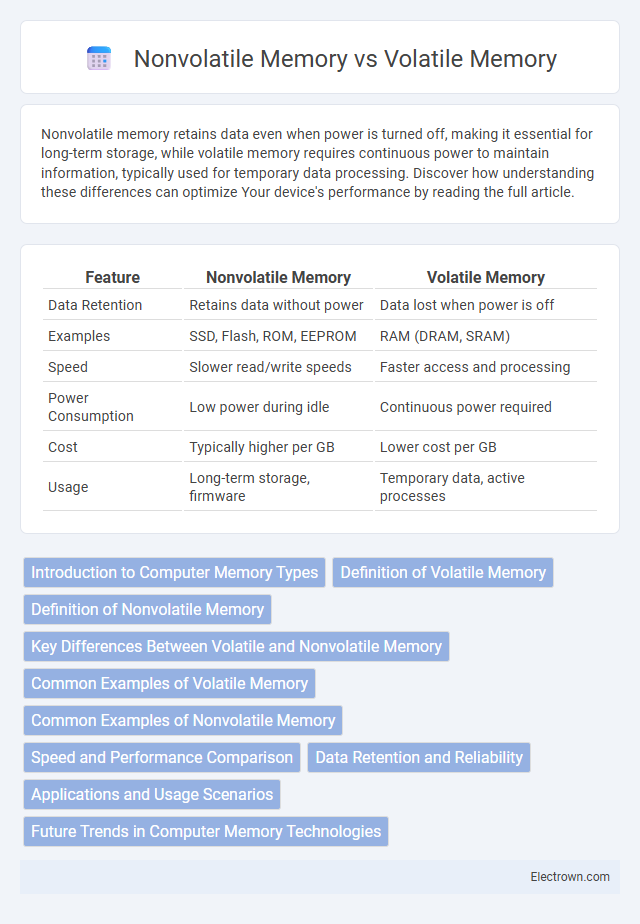Nonvolatile memory retains data even when power is turned off, making it essential for long-term storage, while volatile memory requires continuous power to maintain information, typically used for temporary data processing. Discover how understanding these differences can optimize Your device's performance by reading the full article.
Table of Comparison
| Feature | Nonvolatile Memory | Volatile Memory |
|---|---|---|
| Data Retention | Retains data without power | Data lost when power is off |
| Examples | SSD, Flash, ROM, EEPROM | RAM (DRAM, SRAM) |
| Speed | Slower read/write speeds | Faster access and processing |
| Power Consumption | Low power during idle | Continuous power required |
| Cost | Typically higher per GB | Lower cost per GB |
| Usage | Long-term storage, firmware | Temporary data, active processes |
Introduction to Computer Memory Types
Computer memory consists of volatile and nonvolatile types that serve different functions in data storage and retrieval. Volatile memory, such as RAM, requires continuous power to maintain stored information and offers faster data access for active processes. Nonvolatile memory, including SSDs and flash storage, retains data without power, providing persistent storage essential for long-term data retention and system booting.
Definition of Volatile Memory
Volatile memory is a type of computer memory that requires power to maintain the stored information, losing all data once the power is turned off. It is primarily used for temporary data storage and fast access, essential for active processes and applications. Common examples of volatile memory include RAM (Random Access Memory), which plays a critical role in system performance and multitasking capabilities.
Definition of Nonvolatile Memory
Nonvolatile memory retains stored data even when power is removed, making it essential for long-term data storage in devices like SSDs and flash drives. This contrasts with volatile memory, such as RAM, which loses data when the device is powered off. Understanding the definition of nonvolatile memory helps you choose the right storage solution for preserving critical information.
Key Differences Between Volatile and Nonvolatile Memory
Volatile memory, such as RAM, requires continuous power to retain data, making it ideal for temporary storage and fast access during computing tasks. Nonvolatile memory, including SSDs and flash drives, retains data even when the power is off, ensuring long-term storage and data preservation. The key differences lie in data retention, power dependency, and usage scenarios, with volatile memory optimized for speed and nonvolatile memory designed for durability and persistence.
Common Examples of Volatile Memory
Common examples of volatile memory include Dynamic Random Access Memory (DRAM) and Static Random Access Memory (SRAM), both integral to computer systems for temporary data storage. DRAM is widely used as the main memory due to its high density and cost-effectiveness, while SRAM offers faster access times and is typically used for cache memory. Unlike nonvolatile memory, volatile memory loses stored data when power is turned off, making it essential for active processing tasks.
Common Examples of Nonvolatile Memory
Common examples of nonvolatile memory include SSDs (Solid State Drives), flash drives, and ROM (Read-Only Memory), which retain data even when power is off. EEPROM (Electrically Erasable Programmable Read-Only Memory) is frequently used for firmware storage, allowing modifications without data loss. Your devices often rely on these memory types for persistent data storage and system boot processes.
Speed and Performance Comparison
Nonvolatile memory retains data even when the power is off but typically operates at slower speeds compared to volatile memory, which loses data without power but delivers faster read/write performance essential for active tasks. Your system's overall speed and responsiveness benefit greatly from volatile memory like RAM due to its low latency and high data transfer rates. Nonvolatile memory, such as SSDs or flash storage, offers persistent storage but cannot match the instantaneous access speeds critical for running applications.
Data Retention and Reliability
Nonvolatile memory retains data without power, ensuring persistent storage crucial for reliable system performance, while volatile memory requires continuous power to maintain information, making it prone to data loss during power outages. The inherent data retention of nonvolatile memory enhances system stability and reduces risk in critical applications, whereas volatile memory offers faster access speeds but lacks long-term reliability. Your choice between the two impacts data security and operational continuity, depending on whether you prioritize persistence or speed.
Applications and Usage Scenarios
Nonvolatile memory, such as SSDs and flash storage, is essential for long-term data retention in devices like smartphones, USB drives, and archival systems, enabling persistent storage without power. Volatile memory, including DRAM and SRAM, is used in computer systems for temporary data storage and rapid access during active processing tasks, enhancing speed and performance in applications like gaming, real-time computing, and operating system operations. Industries prioritize nonvolatile memory for data preservation and backup solutions, while volatile memory is critical for system responsiveness and multitasking efficiency.
Future Trends in Computer Memory Technologies
Emerging computer memory technologies prioritize nonvolatile memory (NVM) for its ability to retain data without power, enabling faster and more energy-efficient computing systems. Innovations like Resistive RAM (ReRAM) and Magnetoresistive RAM (MRAM) are expected to revolutionize data storage by combining the speed of volatile memory with the persistence of NVM, enhancing both performance and reliability. Your future devices will benefit from reduced latency and improved data integrity as these advanced memory solutions replace traditional volatile options in next-generation computing architectures.
Nonvolatile Memory vs Volatile Memory Infographic

 electrown.com
electrown.com